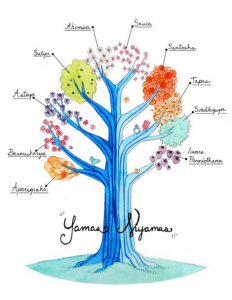The second part of Patanjali's eight-member system contains five internal Niyama practices (observations). These practices extend the code of ethical conduct he created in the first part, the yamas, to the internal environment of yoga, working with the body, mind and spirit. The practice of Niyama helps us cultivate a positive environment that enables growth and gives us the self-discipline and inner strength necessary to continue on the path of yoga.
Shaucha (purification) is the central purpose of many yoga techniques and is the first principle of Patanjali's five Niyamas. Yogis have discovered that both internal and external impurities in our bodies negatively affect our state of mind and prevent the attainment of true wisdom and spiritual liberation. Asana, pranayama and meditation practices cleanse and purify the body and mind and strengthen your ability to maintain yourself in a pure state of being. We must also consciously work to engage with pure environments (including food, drinks, friends, entertainment activities and transportation) so as not to acquire any external impurity in our bodies and minds.
Samtosha (contentment) is about not wanting what we don't have, as well as not coveting the possessions of others. Yogis tell us that when we are completely happy with what life gives us, we attract true joy and happiness. It is easy for the mind to make fools of us when we think we cannot be happy if we have no possessions or possessions, but both our own experience and the teachings of the sages prove that happiness generated through materialism is only temporary. By practicing contentment, we free ourselves from the unnecessary suffering of always wanting things to be different, and at the same time our chests are filled with gratitude and happiness for all the blessings in life.

Tapas (exertion on oneself) is a yoga practice of intense self-discipline and willpower. Basically, Tapas is doing something that will have a positive effect on your life, but you don't want to do it yourself. When our will conflicts with the desire of our mind, a true “fire” is created and it ends up illuminating and burning our physical and mental impurities. Inner fire can also be used as a source of spiritual energy. Yogis say that the exclusive practice of Tapas can lead to the release of kundalini and the attainment of enlightenment. Tapas transforms and purifies us as well as it also gives us awareness and control over our bad behavior and unconscious impulses. Tapas builds willpower and personal strength to help us become more dedicated to the practice of yoga.
svadhyaya (self-study) is the ability to see our divine nature through the contemplation of our life lessons and the truths revealed through the meditation of sages and prophets. Life provides us with endless opportunities to learn about ourselves. Our faults and weaknesses give us the opportunity to grow and our mistakes allow us to learn. Examining our actions ends up becoming a mirror for us to see the motivations, thoughts and desires of our conscious and unconscious more clearly. The practice of Svadhyaya yoga also involves studying spiritual and sacred texts as a guide to our inner world where our true self lives. Learning more about ourselves requires us to look at who we are now and look beyond our current state to realize our connection to the divine.
Ishvara Pranidhana (devotion) is dedication, devotion and surrender to the fruits of a practice to a higher power. This Niyama fuses two common aspects of yoga: devotion to something greater than ourselves and the selfless action of yoga's karma. Patanjali tells us that to achieve the goal of yoga we must separate ourselves from our self-centered nature and let go of our constant identification with ourselves. To do this, our yoga practice and all the benefits we receive through it must be seen as an offering to something greater than ourselves. Through this simple act of dedication we remember our connection to our higher power and our practice becomes something sacred, full of grace, love and inner peace.
The foundation of Patanjali's eight limb yoga trajectory parts, yama and niyama, creates a strong and solid foundation for yogis to engage more deeply in the stages of yoga with focus, inner strength and success. Practicing the Yamas and Niyamas is a journey and a process. Take the first step, one Yama or Niyama at a time, and proceed with compassion and without worrying about perfection. Just as Swami Sri Kripalvanandaji said, “When you take one petal from the crown of yamas and niyamas, the whole crown will follow.”
Written by Amanda Magliaro of Team Me Without Borders

























